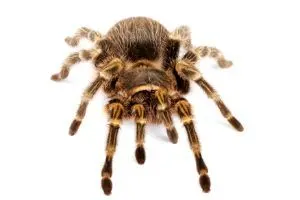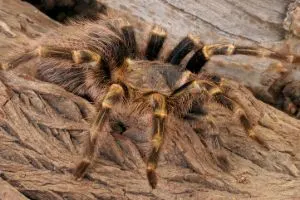Chaco Golden Knee Tarantula Care
Chaco Golden Knee tarantulas are a cool-looking, docile, hardy tarantula that are easy to care for.
They are popular among beginners because of their laid-back nature and the fact that they will sometimes sit around in plain sight and won’t hide away in their burrows all day.
Caring for them is pretty straight-forward since they come from a specific climate and will eat most insects as long as their live.
Here are some useful tips and information on how you can care for your very own Chaco Golden Knee Tarantula:
Quick Reference Section

- Experience Level: Beginner
- Family: Theraphosidae
- Scientific Name: Grammostola pulchripes
- Type: Terrestrial
- Category: New World
- Adult Size: 7 to 8 inches
- Lifespan: Males: 5 to 10 years; Females: 20 to 25 years
- Average Price Range: $18 to $180 per spider (depending on age and size)
- Where to buy: backwaterreptiles.com, myhomenature.com, undergroundreptiles.com
Bioactive Chaco Golden Knee Setup Product List
- Enclosure: Exo Terra Glass terrarium kit
- Soil: Zoo Med Reptisoil
- Moss: Zoo Med terrarium moss
- Hide: Zoo Med cork hide
- Leaf Litter: Sungrow leaf litter
- Hygrometer: Zoomed hygrometer
- Cleaners: Springtails & Isopods
- Water Dish: Zoo Med small water dish
Appearance

While their bodies are usually dark in color overall, ranging from dark brown to black, they will have some unique streaks of long, light-colored hairs.
While these light hairs can grow throughout their bodies, you will see stripes or streaks where this “golden blonde” coloring appears, particularly on their joints. This is how they got their names as the Golden Knee.
These spiders are hardy, heavy-bodied, and large compared to other tarantulas which make them desired among the community.
Habitat
These tarantulas can be found in the warm grasslands of Paraguay and Argentina. These areas will show a climate of both dry spells and rainy seasons alternating with each other, while always remaining warm.
They inhabit grasslands where they are only opportunistic burrowers. They will burrow when they can while they are young and will only inhabit already-existing burrows as they mature.
Diet
In the wild, Chaco Golden Knees will feed on lobster roaches and other large insects. They have also been seen eating small geckos.
Like most wild tarantulas, they also enjoy a diet of smaller invertebrates, consisting of mostly arthropods.
Unlike other tarantulas, they do not create webbed doors in their burrows in order to catch prey. Instead, they will hunt down their prey and eat them alive.
Lifespan

While we don’t have much research on the lifespan of wild tarantulas, we do know that in captivity, males will live for anywhere from 5 to 10 years and females anywhere from 20 to 25 years old.
They have a medium growth rate and their size will differentiate greatly after every molt. Although they aren’t extremely fast growers, you will definitely see more obvious differences after each growth.
They reach sexual maturity around 7 to 8 years old, which is near the end of the male’s life.
Breeding
The Chaco Golden Knee female can lay about 100 to 500 eggs, which take around 6weeks to hatch.
When tarantulas are ready to breed, the male will deposit his sperm in a small silk sac which he will then store in his pedipalps. Tarantula mating rituals are pretty dangerous and can be life or death for the male.
The male tarantula will first search for a mate and invite her to mate. The male will then attempt to deposit his sperm sac into the female’s pedipalps by holding back her pincers and legs so she cannot attack him.
If he can successfully deposit the sac, he will then have a few minutes to flee after copulation since the female will be entranced with chemicals that come with fertilization.
If the male is not careful or the female thinks he is not a suitable mate, he will become her dinner. If copulation is successful and the female is fertilized, she will then protect the clutch of eggs for their incubation period until they hatch.
Check out these successfully incubated eggs on YouTuber CAMANAVA EXOTIC TV’s channel here:
If you are going to attempt to breed your spiders, you need to be fast and ready to remove the male after he fertilizes her.
Legality
In general, tarantulas are legal to keep in most states, although there may be local laws that restrict captivity, breeding, and such. Check out your local laws to find out what is and is not allowed in your state or city.
You can find them at pet stores easily, but we recommend you also try to look for a rescue group or at least make sure you buy from a licensed, reputable breeder.
Chaco Golden Knee Tarantula Care Sheet

Enclosure
Although they are large tarantulas, they actually do not need huge tanks to survive.
A good rule of thumb to follow for any tarantula enclosure is making sure that the width of their enclosure is at least three times your spider’s leg span.
For the Chaco Golden Knee, you will definitely want to give them the space of at least a 15-gallon tank for them to comfortably roam around in.
Since they only really burrow while they are young, you should, however, provide them with some sort of hide or shelter. This can be a piece of bark or a plastic home from your local pet shop.
Make sure you also leave space to place a small, shallow water dish for them.
You might also want to get something that has an escape-proof lid since tarantulas are quite the escape artists.
You should try to keep your spider’s tank clean to reduce the risk of illness. This can be done by taking one day out of your week to clean their tank.
Remove any uneaten food or leftover molt as soon as you see it in their cage.
Substrate
Since they only burrow when they are young, you can give them burrowing-friendly substrates but also provide them with shelter as mentioned above.
They will need a thick layer, or at least 6 inches, of a safe substrate. Good options are coconut fiber, or an organic, chemical-free potting compost.
As they grow, they will burrow less and less, meaning you will not need to worry too much about them if you already provided them with a hide.
You may see them create burrows as they are younger, then just shuffle substrate around as they grow.
Temperature
Keep in mind that the climate in their natural habitat consists of heavy rainfall during the summer and dry spells in the winter. They come from temperatures of around 65 to 78 degrees Fahrenheit and just generally warmer weather.
For the Chaco Golden Knee, they can do fine in room temperatures and will not usually need a heating pad unless your home goes below these numbers.
A heating pad can give your tarantula the option of a warm side, creating a gradient of temperatures for them to choose from in their tank.
Humidity

Chaco Golden Knee Tarantulas strive at humidity levels around 55 to 65 percent.
There is no need to mist their enclosure, but you can just simply provide a shallow dish of water to keep the humidity in.
You want a well-ventilated enclosure to not hold too much moisture from their substrate, which may already hold some moisture in.
Lighting
Don’t worry about lighting but do monitor their tank temperatures since it is more essential to their well-being.
You may also want to get a heating pad to keep temperatures in the enclosure stable.
Feeding
You can feed your pet Chaco Golden Knee grasshoppers, roaches, crickets, as well as other similar insects.
They do not need to be fed that often and should be fine if you give them their live prey around once or twice a week.
Again, do not forget to remove all uneaten food right away after feeding time is over.
Temperament

Because these guys are quite docile and hardy, they make great pets for beginners. Especially females, which are mostly always docile, whereas the males may grow to be more aggressive after they reach sexual maturity.
Most of the time, they have the reputation of being very docile and will first fling their urticating hairs at you or flee in defense before even trying to bite anyone.
Handling
If your tarantula is reacting in a defensive way, it is always best to leave it alone and try not to mess with it until it is more used to you.
When trying to attempt to handle your Chaco Golden Knee, you should be patient and make sure it will not feel threatened.
Tarantulas will fling their hairs, which can cause irritation to handlers. They may also bite handlers, which can be very painful, but their venom has never been known to kill a human. It can be compared to that of a bee sting.
With some time and patience, maybe you can help your tarantula become more accustomed to being handled.
They are very cool spiders to look at, even children can handle them without much worry.
Check out the City of Angelo’s video where children ask their questions about the species of tarantula and one even holds it:
Conclusion
If you’re looking for a striking, hardy, spider that’s pretty straight-forward to care for, and is known for being docile, you will want to take a look at the Chaco Golden Knee Tarantula.
They are attractive for beginners and experts alike, as they make a great addition to any collection. This species can also be the only spider or first that you try to raise.
We hope this article helped you gain some insight on just how cool this spider is and what you need to do to care for it.
You can also gain some more insight from The Tarantula Collective’s Video here:
If you have any questions, leave them in the comment section below!
More tarantulas stuff
Table of Contents
